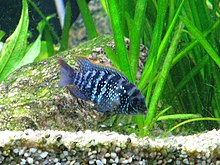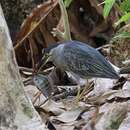Diagnostic Description
provided by Fishbase
Aequidens is very similar to Geophagus but is differentiated by the number of spines on the anal fin and the lacks of a lobule on the first branchial arch found in Geophagus; live specimens olive green, with eight obscure transverse bands on the body; numerous bright bluish-green lines on the cheek; males are more colorful and grow bigger than females; males blue in color during the reproductive season (Ref. 26543).
- Recorder
- Cristina V. Garilao
Diseases and Parasites
provided by Fishbase
White spot Disease. Parasitic infestations (protozoa, worms, etc.)
Diseases and Parasites
provided by Fishbase
Costia Disease. Parasitic infestations (protozoa, worms, etc.)
Diseases and Parasites
provided by Fishbase
Turbidity of the Skin (Freshwater fish). Parasitic infestations (protozoa, worms, etc.)
Diseases and Parasites
provided by Fishbase
Bacterial Infections (general). Bacterial diseases
Life Cycle
provided by Fishbase
In captivity, both male and female clean a rock which will be the spawning area. Eggs are laid on the rock by the female and fertilized by the male. Both male and female guard the eggs, which hatch in 2 to 5 days, and continue to look after the fry for some weeks (Ref. 7020). In cases of danger, the male protects its young by placing them inside its mouth (Ref. 26543).
Morphology
provided by Fishbase
Anal spines: 3
- Recorder
- Cristina V. Garilao
Trophic Strategy
provided by Fishbase
Inhabits turbid standing waters as well as clear free flowing streams (Ref. 11225). Feeds on worms, crustaceans and insects (Ref. 7020). Reproduces in captivity (Ref. 26543).
Biology
provided by Fishbase
Inhabits turbid standing waters as well as clear free flowing streams (Ref. 11225). Feeds on worms, crustaceans and insects (Ref. 7020). Reproduces in captivity (Ref. 26543). Both parents guard the eggs and larvae (Ref. 7020). Has been used to control mosquito larvae (Ref. 40602). Aquarium keeping: in pairs; minimum aquarium size 100 cm (Ref. 51539).
Importance
provided by Fishbase
fisheries: commercial; aquarium: highly commercial
Blue acara
provided by wikipedia EN
The blue acara (Andinoacara pulcher) is a colorful freshwater fish in the cichlid family.[2] This fish can be found in various freshwater habitats, ranging from standing water to flowing streams, in Venezuela and Trinidad.[3] They can reach lengths of 16 cm (6.3 in).[3] The scientific species name is indicative to its looks; pulcher meaning "beautiful" in Latin. The blue acara is a common cichlid sold in many aquarium stores, and is sometimes confused with the larger green terror (A. rivulatus).
The body of the blue acara is stocky and compact with a steel blue-gray coloration. Noticeable horizontal green lines occur on their faces and their blueish-green scales give them a sparkling appearance. They also have long, flowing fins with a hint of orange to the tips.
Blue acaras natively live in a tropical climate and prefer water with a pH of 6.5-8.0, a water hardness of 25° dGH, and a water temperature of 22–30 °C (72–86 °F).[4][5]
Description

A wild-morph acara in a home aquarium
The blue acara normally grows to around 13 cm (5.1 in), but can reach up to 16 cm (6.3 in).[3] The body is compact and stocky, while the fins are long and flowing, with a rounder head than on similar cichlids.
The main body colour can vary from browns to blues to black due to local diversity. The body is decorated with five to eight vertical black stripes (which may not always be distinctly visible) and blue iridescent spots, and the face sports a few horizontal green lines. The fins have a hint of orange on the tips and some specimens have a red topfin rim. A distinctive black line is present going from the eye down the cheek; this one line is not found on other similar cichlids.
Taxonomy
Formerly placed in the genus Aequidens, this species was moved to Andinoacara in 2009.[2][6]
References
-
^ "Andinoacara pulcher". IUCN Red List of Threatened Species.
-
^ a b "Phylogeny of the Neotropical cichlid fish tribe Cichlasomatini (Teleostei: Cichlidae) based on morphological and molecular data, with the description of a new genus. Journal of Zoological Systematics and Evolutionary Research. Volume 47 Issue 3, Pages 234 - 247." [1]
-
^ a b c Froese, Rainer; Pauly, Daniel (eds.) (2017). "Andinoacara pulcher" in FishBase. May 2017 version.
-
^ "Avila, Marcos A (1997-2008). "Aequidens Pulcher", The Age of Aquariums."[2]
-
^ "Brough, David (1998-2008). "Aquidens Pulcher, Blue Acara", Dr. Jungle's Animal World."[3]
-
^ N., S.O. Kullander and R.E. Barriga Salazar, 2012. Andinoacara blombergi, a new species from the Río Esmeraldas basin in Ecuador and a review of A. rivulatus (Teleostei: Cichlidae). Ichthyol. Explor. Freshwat. 23(2):117-137.

- license
- cc-by-sa-3.0
- copyright
- Wikipedia authors and editors
Blue acara: Brief Summary
provided by wikipedia EN
The blue acara (Andinoacara pulcher) is a colorful freshwater fish in the cichlid family. This fish can be found in various freshwater habitats, ranging from standing water to flowing streams, in Venezuela and Trinidad. They can reach lengths of 16 cm (6.3 in). The scientific species name is indicative to its looks; pulcher meaning "beautiful" in Latin. The blue acara is a common cichlid sold in many aquarium stores, and is sometimes confused with the larger green terror (A. rivulatus).
The body of the blue acara is stocky and compact with a steel blue-gray coloration. Noticeable horizontal green lines occur on their faces and their blueish-green scales give them a sparkling appearance. They also have long, flowing fins with a hint of orange to the tips.
Blue acaras natively live in a tropical climate and prefer water with a pH of 6.5-8.0, a water hardness of 25° dGH, and a water temperature of 22–30 °C (72–86 °F).
- license
- cc-by-sa-3.0
- copyright
- Wikipedia authors and editors

